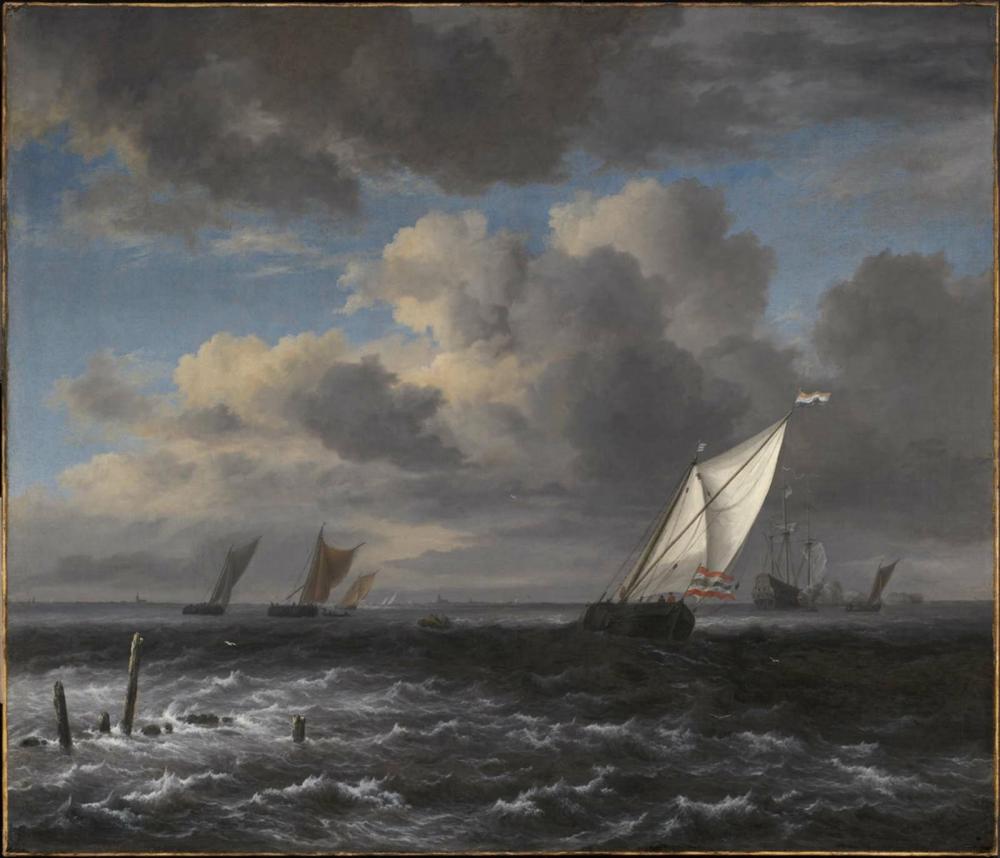Advanced Search 

Rough Sea
Jacob Isaacksz. van Ruisdael (Dutch, 1628 or 1629–1682)
about 1670
Medium/Technique
Oil on canvas
Dimensions
107.0 x 125.8 cm (42 1/8 x 49 1/2 in.)
Credit Line
William Francis Warden Fund
Accession Number57.4
OUT ON LOAN
CollectionsEurope
ClassificationsPaintings
Water was, and is, inescapable in the Netherlands. It presented both threat and opportunity, and this painting by Ruisdael hints at both. The whitecaps and the sharp “heel” (or tilt) of the ships suggest a strong breeze that could challenge a sailor. In the lower left, pilings of broken logs indicate dangerously shallow water, yet the ship in the foreground is on the right course. The sun breaks through the retreating storm clouds to illuminate its sail and the flag of the Netherlands. Here, the artist may have intended to suggest that fortune favored the Dutch.
InscriptionsLower left: Ruisdael
ProvenanceAcquired in Holstein, Germany by Georg Ernst Harzen (b. 1790 - d. 1863), Hamburg. Richard Foster (d. 1830), Clewer Park, Berkshire, England; by descent to Edmund Foster (d. 1863), Clewer Park; by descent to Edmund Benson Foster (b. about 1850), Clewer Park; July 13, 1895, Richard Foster sale, Christie, Manson, and Woods, London, lot 70, to Colnaghi. Alfred Beit (b. 1853 - d. 1906), London; 1906, by inheritance to his brother, Sir Otto John Beit (b. 1865 - d. 1930), London [see note 1]; 1930, probably by inheritance to his widow or his son, Sir Alfred Lane Beit (b. 1903 - d. 1994), London [see note 2]. 1956, H. J. Spiller, London; July 30, 1956, sold by Spiller to Duits, London (stock no. 604) [see note 3]; 1956, sold by Duits to Rudolf J. Heinemann (dealer, b. 1902 - d. 1975), New York [see note 4]; 1957, sold by Heinemann to the MFA for $39,000. (Accession Date: January 10, 1957)
NOTES:
[1] The painting was in his possession until at least 1929, when he lent it to the Exhibition of Dutch Art, 1450-1900 (London: Royal Academy of Art, 1929), cat. no. 100.
[2] Upon Otto Beit's death in 1930, his collection was divided between his widow and his son. See Adrian Le Harivel et al., "The Beit Collection" (Dublin: National Gallery of Ireland, 1988).
[3] According to information on file at the Getty Research Institute (Duits Records, Accession No. 860290, boxes 16 and 37), Duits acquired a half-share in the painting at this time.
[4] Agnew's, London, purchased a half-share in the painting from Heinemann in October, 1956 and sold it back to him in February, 1957.
NOTES:
[1] The painting was in his possession until at least 1929, when he lent it to the Exhibition of Dutch Art, 1450-1900 (London: Royal Academy of Art, 1929), cat. no. 100.
[2] Upon Otto Beit's death in 1930, his collection was divided between his widow and his son. See Adrian Le Harivel et al., "The Beit Collection" (Dublin: National Gallery of Ireland, 1988).
[3] According to information on file at the Getty Research Institute (Duits Records, Accession No. 860290, boxes 16 and 37), Duits acquired a half-share in the painting at this time.
[4] Agnew's, London, purchased a half-share in the painting from Heinemann in October, 1956 and sold it back to him in February, 1957.
